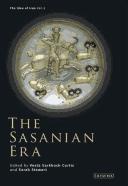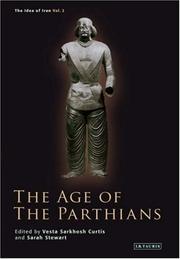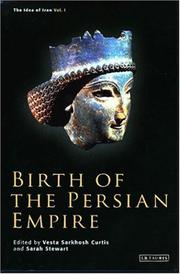| Listing 1 - 10 of 13 | << page >> |
Sort by
|
Book
ISBN: 9781780769479 1780769474 9780857738110 0857738119 Year: 2015 Volume: 6 Publisher: London I. B. Tauris
Abstract | Keywords | Export | Availability | Bookmark
 Loading...
Loading...Choose an application
- Reference Manager
- EndNote
- RefWorks (Direct export to RefWorks)
From their ancestral heartland by the shores of the Aral Sea, the medieval Oghuz Turks marched westwards in search of dominion. Their conquests led to control of a Muslim empire that united the territories of the Eastern Islamic world, melded Turkic and Persian influences and transported Persian culture to Anatolia. In the eleventh and twelfth centuries the new Turkic-Persian symbiosis that had earlier emerged under the Samanids, Ghaznavids and Qarakha-nids came to fruition in a period that, under the enlightened rule of the Seljuq dynasty, combined imperial grandeur with remarkable artistic achievement. This latest volume in The Idea of Iran series focuses on a system of government based on Turkic 'men of the sword' and Persian 'men of the pen' that the Seljuqs (famous foes of the Crusader Frankish knights) consolidated in a form that endured for centuries. The book further explores key topics relating to the innovative Seljuq era, including: conflicted Sunni-Shi'a relations between the Sunni Seljuq Empire and Ismaili Fatimid caliphate; architecture, art and culture; and politics and poetry.Istvan Vasary looks back in Chapter 1 to the early history of the Turks in the wider Iranian world, discussing the debates about the dating and distribution of the early Turkish presence in Central Asia, Iran and Afghanistan.
Seljuks --- Seljuks. --- History. --- Iran --- Iran. --- History --- HISTORY / Middle East / General. --- 640-1256. --- History / middle east / general. --- Seldjoukides (dynastie)
Book
ISBN: 9781780760612 1780760612 Year: 2012 Publisher: London I. B. Tauris
Abstract | Keywords | Export | Availability | Bookmark
 Loading...
Loading...Choose an application
- Reference Manager
- EndNote
- RefWorks (Direct export to RefWorks)
Islam --- 640-1256. --- Zoroastrianism --- Civilization. --- Islam. --- Religion. --- Zoroastrianism. --- History --- Iran --- Iran.
Book
Year: 1988 Publisher: London : Corgi books,
Abstract | Keywords | Export | Availability | Bookmark
 Loading...
Loading...Choose an application
- Reference Manager
- EndNote
- RefWorks (Direct export to RefWorks)
Book
ISBN: 090599020X Year: 1983 Publisher: London : War on Want,
Abstract | Keywords | Export | Availability | Bookmark
 Loading...
Loading...Choose an application
- Reference Manager
- EndNote
- RefWorks (Direct export to RefWorks)
Book
ISBN: 9783447111294 Year: 2018 Publisher: Wiesbaden : Harrassowitz Verlag,
Abstract | Keywords | Export | Availability | Bookmark
 Loading...
Loading...Choose an application
- Reference Manager
- EndNote
- RefWorks (Direct export to RefWorks)
Zoroastrianism --- Oral history --- History --- Iran --- Religion.

ISBN: 9781845116903 1845116909 Year: 2008 Volume: 3 Publisher: London ; New York I.B. Tauris
Abstract | Keywords | Export | Availability | Bookmark
 Loading...
Loading...Choose an application
- Reference Manager
- EndNote
- RefWorks (Direct export to RefWorks)
This latest volume in "The Idea of Iran" series concentrates on the Sasanian period. Seizing power from the previous dynasty - the Parthians - the Sasanians ruled Iran and most of the ancient Near East from 224 until 642 CE. They are particularly fascinating because of their adherence to Zoroastrianism, an ancient dualistic Iranian religion named after the prophet Zarathustra (or, in Greek, Zoroaster). The Sasanians expressed the divine aspect of their rule in a variety of forms, such as on coins, rock reliefs and silver plates, and architecture and the arts flourished under their aegis. Sasanian military success brought them into conflict with Rome, and later Byzantium. Their empire eventually collapsed under the force of the Arab army in AD 642, when Zoroastrianism was replaced with Islam.Engaging with all the major aspects of Sasanian culture, twelve eminent scholars address subjects which include: early Sasanian art and iconography; early Sasanian coinage; religion and identity in the Sasanian empire; later Sasanian orality and literacy; and state and society in late antique Iran.The volume in question arguably comprises the most complete and comprehensive treatment of the Sasanian civilization yet to be published in English.
Sassanids --- Sassanides --- Iran --- History --- Histoire --- Sassanides (dynastie) --- Monnaies sassanides

ISBN: 9781845114060 184511406X Year: 2007 Volume: 2 Publisher: London ; New York I.B. Tauris Publishers
Abstract | Keywords | Export | Availability | Bookmark
 Loading...
Loading...Choose an application
- Reference Manager
- EndNote
- RefWorks (Direct export to RefWorks)
Parthes --- Arsacides (dynastie) --- Iran --- Civilisation --- Parthians. --- Coins, Parthian. --- Monnaies parthes --- History --- Histoire --- Parthes.

ISBN: 9781845110628 1845110625 Year: 2008 Volume: 1 Publisher: London ; New York I.B. Tauris Publishers
Abstract | Keywords | Export | Availability | Bookmark
 Loading...
Loading...Choose an application
- Reference Manager
- EndNote
- RefWorks (Direct export to RefWorks)
This book explores the formation of the first Persian Empire under the Achaemenid Persians. It brings together a multi-disciplinary view of ancient Iran in the first millennium BC and concentrates on the art, archaeology, history and religion of a vast geographical area far beyond the present borders of modern Iran in the period beginning just before the formation of the Persian empire in the middle of the 6th century up to its collapse following conquest by Alexander the Great in the late 4th century BC. Eminent scholars offer a critical approach to some of the traditional interpretations and guide the reader towards a better understanding of the formation of the Persian empire. This is the first volume in the four-volume 'Idea of Iran' series.
Iran --- History --- Civilization --- Histoire --- Civilisation
Book
ISBN: 1350989436 0857728156 0857728865 9780857728159 9780857728869 9781784536336 1784536334 Year: 2016 Publisher: London, England : London, England : I.B. Tauris & Co. Ltd, Bloomsbury Publishing,
Abstract | Keywords | Export | Availability | Bookmark
 Loading...
Loading...Choose an application
- Reference Manager
- EndNote
- RefWorks (Direct export to RefWorks)
"Zoroastrianism has always commanded interest way beyond the circles of its actual adherents. Its unbroken history and distinctive beliefs span three millennia, making it one of the world's most venerable faiths - and also a tradition whose ideas have found favour elsewhere. The Three Magi of the New Testament most probably were Zoroastrian priests from the Iranian world; while the enigmatic figure of Zarathushtra (or Zoroaster) himself has exerted continual fascination in the West, influencing the thought of creative artists as diverse as Voltaire, Nietzsche, Yeats and Mozart (whose opera The Magic Flute re-imagines Zoroaster as Sarastro). For many centuries, from the birth of the religion late in the second millennium BC to its later adoption in the third century AD as the state religion of the Sasanian empire, Zoroastrianism - enjoying imperial patronage - profoundly shaped the culture not just of Persia but the whole antique world. For much of its history since the Islamic conquest it has endured as a minority religion, representing a direct link back to the powerful Achaemenids and the ruling Persian dynasties that followed them. The remarkable Zoroastrian story began another chapter in India when, after partial exodus from Iran, the émigré community since the early ninth century has enjoyed religious freedom and in the modern period great economic success. Like many religious communities, Zoroastrians now have a diaspora spread all over the globe."--Front jacket flap.
Zoroastrianism. --- Mazdaism --- Mazdeism --- Religions --- Mithraism
Book
ISBN: 9781845116910 1845116917 Year: 2009 Volume: v. 4 Publisher: London: Tauris Academis Studies,
Abstract | Keywords | Export | Availability | Bookmark
 Loading...
Loading...Choose an application
- Reference Manager
- EndNote
- RefWorks (Direct export to RefWorks)
"The latest volume in the successful series The Idea of Iran addresses the impact made by Islam during and after the Arab conquest of Iran in the middle of the seventh century. How and why, once Iran had embraced the new religion, did it manage to retain its Persian language and distinctive Iranian identity once Muslim governance took hold? This conundrum, alongside other important questions, is addressed by the book, which includes seven distinguished contributions from leading scholars. Discussing a large variety of subjects which covers the whole spectrum of life in early Islamic Iran, the volume offers one of the most ambitious perspectives on Persian religion, society and culture to be published to date. It will be consulted by all students of Iranian history, and will be regarded as essential reading for scholars of Islam, the Middle East and medieval religion alike."--Jacket.
Islam --- History. --- Histoire --- Iran --- History --- Civilization. --- Religious life and customs. --- Civilisation --- Vie religieuse --- Civilization --- Religious life and customs --- Islam. --- Historia --- Historia. --- Geschichte. --- Iran. --- Islam - Iran - History --- Iran - History - 640-1256 --- Iran - Civilization --- Iran - Religious life and customs
| Listing 1 - 10 of 13 | << page >> |
Sort by
|

 Search
Search Feedback
Feedback About UniCat
About UniCat  Help
Help News
News